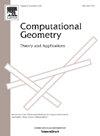Pattern formation for fat robots with lights
IF 0.4
4区 计算机科学
Q4 MATHEMATICS
Computational Geometry-Theory and Applications
Pub Date : 2024-12-27
DOI:10.1016/j.comgeo.2024.102161
引用次数: 0
Abstract
Given a set of unit disk robots in the Euclidean plane, we consider the Pattern Formation problem, i.e., the robots must reposition themselves to form a given target pattern. This problem arises under obstructed visibility, where a robot cannot see another robot if there is a third robot on the straight line segment between the two robots. Recently, this problem was solved in the asynchonous model for fat robots that agree on at least one axis in the robots with lights model where each robot is equipped with an externally visible persistent light that can assume colors from a fixed set of colors [1]. In this work, we reduce the number of colors needed and remove the axis-agreement requirement in the fully synchronous model. In particular, we present an algorithm requiring 7 colors when scaling the target pattern is allowed and an 8-color algorithm if scaling is not allowed. Our algorithms run in rounds with probability at least .
有光的胖机器人的模式形成
给定欧几里得平面上的一组n≥1个单元的圆盘机器人,我们考虑模式形成问题,即机器人必须重新定位自己以形成给定的目标模式。这个问题出现在能见度受阻的情况下,如果在两个机器人之间的直线段上有第三个机器人,机器人就看不到另一个机器人。最近,这个问题在胖机器人的异步模型中得到了解决,在机器人带灯模型中,每个机器人都配备了一个外部可见的持久光,可以从一组固定的颜色中选择颜色[1]。在这项工作中,我们减少了所需的颜色数量,并消除了完全同步模型中的轴一致要求。特别是,我们提出了一种算法,当允许缩放目标图案时需要7种颜色,如果不允许缩放则需要8种颜色。我们的算法运行在O(n)+O(qlog (n))轮中,概率至少为1−n−q。
本文章由计算机程序翻译,如有差异,请以英文原文为准。
求助全文
约1分钟内获得全文
求助全文
来源期刊
CiteScore
1.60
自引率
16.70%
发文量
43
审稿时长
>12 weeks
期刊介绍:
Computational Geometry is a forum for research in theoretical and applied aspects of computational geometry. The journal publishes fundamental research in all areas of the subject, as well as disseminating information on the applications, techniques, and use of computational geometry. Computational Geometry publishes articles on the design and analysis of geometric algorithms. All aspects of computational geometry are covered, including the numerical, graph theoretical and combinatorial aspects. Also welcomed are computational geometry solutions to fundamental problems arising in computer graphics, pattern recognition, robotics, image processing, CAD-CAM, VLSI design and geographical information systems.
Computational Geometry features a special section containing open problems and concise reports on implementations of computational geometry tools.

 求助内容:
求助内容: 应助结果提醒方式:
应助结果提醒方式:


